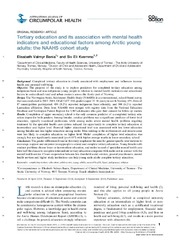| dc.contributor.author | Bania, Elisabeth Valmyr | |
| dc.contributor.author | Kvernmo, Siv Eli | |
| dc.date.accessioned | 2016-09-30T12:43:19Z | |
| dc.date.available | 2016-09-30T12:43:19Z | |
| dc.date.issued | 2016-09-27 | |
| dc.description.abstract | <b>Background. </b>Completed tertiary education is closely associated with employment and influences income, health and personal well-being.
<br>
<b>Objective. </b>The purpose of the study is to explore predictors for completed tertiary education among indigenous Sami and non-indigenous young people in relation to mental health indicators and educational factors in sociocultural rural and urban contexts across the Arctic part of Norway.
<br>
<b>Design.</b> The Norwegian Arctic Adolescent Health Study (NAAHS) is a cross-sectional, school-based survey that was conducted in 2003–2005. Of all 5,877 10th graders (aged 15–16 years) in north Norway, 83% from all 87 municipalities participated; 450 (9.2%) reported indigenous Sami ethnicity, and 304 (6.2%) reported Laestadian affiliation. Data from NAAHS were merged with registry data from the National Education Database and Norwegian Patient Register for 3,987 adolescents who gave their consent for follow-up studies.
<br>
<b>Results. </b>Completion of upper secondary school is the only common predictor of a completed tertiary education degree for both genders. Among females, conduct problems was a significant predictor of lower level education, typically vocational professions, while among males severe mental health problems requiring treatment by the specialist health care system reduced the opportunity to complete tertiary education at intermediate and higher level. Parental higher educational level was associated with less lower education among females and less higher education among males. Men residing in the northernmost and remote areas were less likely to complete education on higher level. Males’ completion of higher level education was strongly but not significantly associated (p=0.057) with higher average marks in lower secondary school.
<br>
<b>Conclusions.</b> The gender differences found in this study emphasize the need for gender-specific interventions to encourage, support and empower young people to attend and complete tertiary education. Young females with conduct problems choose lower or intermediate education, and males in need of specialist mental health care have half the chance to complete intermediate tertiary education compared with males not in contact with the mental health service. Closer cooperation between low threshold social services, general practitioners, mental health services and higher study institutions can help young male adults complete tertiary education. | en_US |
| dc.description.sponsorship | The authors have not received any funding or benefits from industry or elsewhere to conduct this study. | en_US |
| dc.description | Publisher's version, source: <a href=http://dx.doi.org/10.3402/ijch.v75.32086>http://dx.doi.org/10.3402/ijch.v75.32086</a>. | en_US |
| dc.identifier.citation | International Journal of Circumpolar Health 2016, 75: 32086 | en_US |
| dc.identifier.cristinID | FRIDAID 1387026 | |
| dc.identifier.doi | http://dx.doi.org/10.3402/ijch.v75.32086 | |
| dc.identifier.doi | | |
| dc.identifier.issn | 1239-9736 | |
| dc.identifier.issn | 2242-3982 | |
| dc.identifier.uri | https://hdl.handle.net/10037/9762 | |
| dc.language.iso | eng | en_US |
| dc.publisher | Co-Action Publishing | en_US |
| dc.relation.projectID | Sparebankforeningen: gavefond | |
| dc.relation.projectID | Andre: SANKS (Samisk nasjonalt kompetansesenter for psykisk helse) | |
| dc.rights.accessRights | openAccess | |
| dc.subject | Elevers psykiske helse / Students' mental health | en_US |
| dc.subject | Folkehelse / Public Health | en_US |
| dc.subject | Samfunnsøkonomiske implikasjoner / Public health | en_US |
| dc.subject | VDP::Medisinske Fag: 700::Klinisk medisinske fag: 750::Psykiatri, barnepsykiatri: 757 | en_US |
| dc.subject | VDP::Medisinske Fag: 700::Helsefag: 800::Samfunnsmedisin, sosialmedisin: 801 | en_US |
| dc.subject | completing tertiary education | en_US |
| dc.subject | adolescents | en_US |
| dc.subject | young adults | en_US |
| dc.subject | mental health | en_US |
| dc.subject | Sami | en_US |
| dc.subject | indigenous | en_US |
| dc.subject | religion | en_US |
| dc.title | Tertiary education and its association with mental health indicators and educational factors among Arctic young adults: the NAAHS cohort study | en_US |
| dc.type | Journal article | en_US |
| dc.type | Tidsskriftartikkel | en_US |
| dc.type | Peer reviewed | en_US |


 English
English norsk
norsk


